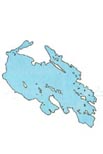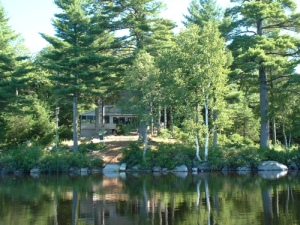 |
||||||||||||||||
|
© 2004 Beth Teele-Haidinger |
||||||||||||||||
|
last updated: June 25, 2015 |
||||||||||||||||
|
|
||||||||||||||||
|
The Eaton Camp at Meddybemps Lake Henry Boardman Eaton II was the youngest child of Charles Freedom and Alice Murchie Eaton. The family was one of the original lumber enterprises and largest landowners along both sides of the St. Croix River, dating back to the mid-1850’s. They had homes in Calais, Princeton and Forest, Maine, used at various times of the year as they followed the flow of logs and lumber from the shores of the Chipetnicook Lakes down the upper St. Croix to Grand Lake to the mills straddling the river in Milltown (both ME & NB), until finally reaching the docks in Calais. The family established their first camp on Meddybemps Lake at the tip of Scott’s Arm sometime around the turn of the century, at what is now known as Eaton Point. It was a beautiful collection of buildings framed by lovely whole log, white birch fencing. A surviving building still stands today. We know it as Rudolph’s cabin, named after the camp caretaker. Many lake people may recall the steady collapse of the covered boathouse. As children, it was an annual rite to inspect that winter’s damage as measured by the diminishing space between the roof and the lake. The Eaton Point camp was built and owned by Henry and Emma Murchie Eaton, my grandfather’s namesake and his wife, the sister of my great grandmother. They had no children, so doted on their relatives. The camp stayed in the family after Henry and Emma passed away, after which my grandparents and other family members continued to use it. As children, my mother and her sisters took boating picnics to St. Helena and Center Islands just as we do today. My grandfather and his brothers however, favored a more adventurous lifestyle in their youth. They joined Passamaquoddy natives, Tomah Joe and Tomah Gabriel in paddling the St. Croix, fishing, hunting and camping, even if it meant skipping school. Our family love of canoeing no doubt finds its way back to this source. Most of the buildings at Eaton Point were destroyed by fire in the mid-1940’s. The depression, World War II, in which my grandfather participated, and the fact that this generation of Eatons was living in Massachusetts and New York, essentially left the Eaton Point property in disuse for over a decade. This is when the spine-bending boathouse began its descent into the lake. It was a time of life transitions for my grandparents. One, they settled into the Eaton family home on Hinkley Hill in Calais, after living in New York. Two, Todd Brothers Hardware was purchased as an entry into rebuilding the family business in timber and lumber. And three, they wanted to set up another camp at Meddybemps Lake. The entangled interests of the family dissuaded a return to Eaton Point. Instead, in the late 1940’s, the Chase camp in Sunset Cove was leased for a year or two, as a way of “trying it on.” The Chase’s had a lovely home in Baring and were known by the Eatons. My grandparents bought the camp and started renovations to brighten it and replace the maize of small rooms with a single large one facing the lake. The front porch, shading the entire interior, was removed. Custom timbers, to span the distance to support the second story, were procured, cut and installed, while floor-to-ceiling plate glass windows added light and exposed the lake view. Teams of horses were brought in by a local farmer to install the huge timbers and rocks forming the crib for the covered boathouse, modeled after the endearing one on Eaton Point. The camp that we occupy and enjoy today was largely constructed at this time. |
|||||||||||||||||||||||||||||||||||||||||||||||||||||||||||||||||||||||||||||||||||||||
 |
|||||||||||||||||||||||||||||||||||||||||||||||||||||||||||||||||||||||||||||||||||||||
|
It has never been revealed whether my grandfather’s infamous incident of firing a gun at raucous red squirrels from bed one night was before or after the purchase of the camp. The story does claim though, that the next morning he repaired the damage caused by his intemperate shots. In December 1950, my grandfather was accidentally killed by heavy equipment during the construction of a ski hill on the Passamaquoddy Reservation. A half-year later my parents celebrated their marriage, entertaining hundreds of guests at the family camp on Meddybemps Lake. This event triggered another round of renovations, now conducted by James Murchie Eaton, my grandfather’s oldest brother. He also offered my mother’s hand at the Calais wedding. My grandmother, Jean Ganong Eaton stepped in to run Todd Brothers, which she did for over twenty years. She spent every summer out at the lake, which became flooded with grandchildren for a month or so each year. The oldest of us remember how she would find excuses “to return to town” when she reached her limit with the constant commotion. She died in 1980. Both the Ganong and Eaton families are buried in the St. Stephen Rural Cemetery. Those summers passed into present day ones without skipping a beat. Now my generation, Jean and Henry’s grandchildren, bring our own kids to the lake in annual pilgrimages. And like our forbearers, boating, exploring and fishing fulfill our days. I’ve always associated our camp on Meddybemps Lake as my spiritual home. Having moved a half dozen times as a child, then relocating for college and finally establishing my own life in Seattle, the camp at Meddybemps has been the one constant home in my life. I know in degrees this holds true for my siblings and cousins, too. We are forever grateful to our ancestors, especially our grandparents, for creating this legacy for us. |
|||||||||||||||||||||||||||||||||||||||||||||||||||||||||||||||||||||||||||||||||||||||
|
Submitted by Dave Mauk, - May 31, 2006 |
|||||||||||||||||||||||||||||||||||||||||||||||||||||||||||||||||||||||||||||||||||||||
|
2012 Dennys River and Lake Meddybemps Water Management, by Colby Bruchs |
|||||||||||||||||||||||||||||||||||||||||||||||||||||||||||||||||||||||||||||||||||||||
|
Photos from Pete from the Superfund Site - Indian Tribute, Sept. 2012. |
|||||||||||||||||||||||||||||||||||||||||||||||||||||||||||||||||||||||||||||||||||||||
|
For a peek at what is being sold by the LMA, click here |
|||||||||||||||||||||||||||||||||||||||||||||||||||||||||||||||||||||||||||||||||||||||
|
|||||||||||||||||||||||||||||||||||||||||||||||||||||||||||||||||||||||||||||||||||||||





